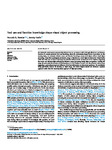Tool use and function knowledge shape visual object processing
| dc.contributor.author | Foerster, FR | |
| dc.contributor.author | Goslin, Jeremy | |
| dc.date.accessioned | 2022-02-09T17:15:03Z | |
| dc.date.issued | 2021-09 | |
| dc.identifier.issn | 0301-0511 | |
| dc.identifier.issn | 1873-6246 | |
| dc.identifier.other | 108143 | |
| dc.identifier.uri | http://hdl.handle.net/10026.1/18736 | |
| dc.description.abstract |
Perceiving the environment automatically informs how we can interact with it through affordance mechanisms. However, it remains unknown how our knowledge about the environment shapes how it is perceived. In this training study, we evaluated whether motor and function knowledge about novel objects affects visual object processing. Forty-three participants associated a usage or function to a novel object in interactive virtual reality while their EEG was recorded. Both usage and function influenced the mu-band (8-12 Hz) rhythms, suggesting that motor and function object information influence motor processing during object recognition. Learning the usage also prevented the reduction of the theta-band (4-8 Hz) rhythms recorded over the posterior cortical areas, suggesting a predominant top-down influence of tool use information on visuo-motor pathways. The modulation being specifically induced by learning an object usage, the results support further the embodied cognition approach rather than the reasoning-based approach of object processing. | |
| dc.format.extent | 108143-108143 | |
| dc.format.medium | Print-Electronic | |
| dc.language | en | |
| dc.language.iso | en | |
| dc.publisher | Elsevier | |
| dc.subject | EEG | |
| dc.subject | Affordance | |
| dc.subject | Object processing | |
| dc.subject | Embodied cognition | |
| dc.subject | Tool use | |
| dc.title | Tool use and function knowledge shape visual object processing | |
| dc.type | journal-article | |
| dc.type | Journal Article | |
| dc.type | Research Support, Non-U.S. Gov't | |
| plymouth.author-url | https://www.webofscience.com/api/gateway?GWVersion=2&SrcApp=PARTNER_APP&SrcAuth=LinksAMR&KeyUT=WOS:000692440900001&DestLinkType=FullRecord&DestApp=ALL_WOS&UsrCustomerID=11bb513d99f797142bcfeffcc58ea008 | |
| plymouth.volume | 164 | |
| plymouth.publication-status | Published | |
| plymouth.journal | Biological Psychology | |
| dc.identifier.doi | 10.1016/j.biopsycho.2021.108143 | |
| plymouth.organisational-group | /Plymouth | |
| plymouth.organisational-group | /Plymouth/Faculty of Health | |
| plymouth.organisational-group | /Plymouth/REF 2021 Researchers by UoA | |
| plymouth.organisational-group | /Plymouth/REF 2021 Researchers by UoA/UoA04 Psychology, Psychiatry and Neuroscience | |
| plymouth.organisational-group | /Plymouth/REF 2021 Researchers by UoA/UoA04 Psychology, Psychiatry and Neuroscience/UoA04 REF peer reviewers | |
| plymouth.organisational-group | /Plymouth/Research Groups | |
| plymouth.organisational-group | /Plymouth/Research Groups/Centre for Brain, Cognition and Behaviour (CBCB) | |
| plymouth.organisational-group | /Plymouth/Research Groups/Centre for Brain, Cognition and Behaviour (CBCB)/Brain | |
| plymouth.organisational-group | /Plymouth/Users by role | |
| plymouth.organisational-group | /Plymouth/Users by role/Academics | |
| dc.publisher.place | Netherlands | |
| dcterms.dateAccepted | 2021-07-01 | |
| dc.rights.embargodate | 2022-7-20 | |
| dc.identifier.eissn | 1873-6246 | |
| dc.rights.embargoperiod | Not known | |
| rioxxterms.versionofrecord | 10.1016/j.biopsycho.2021.108143 | |
| rioxxterms.licenseref.uri | http://www.rioxx.net/licenses/all-rights-reserved | |
| rioxxterms.licenseref.startdate | 2021-09 | |
| rioxxterms.type | Journal Article/Review |


